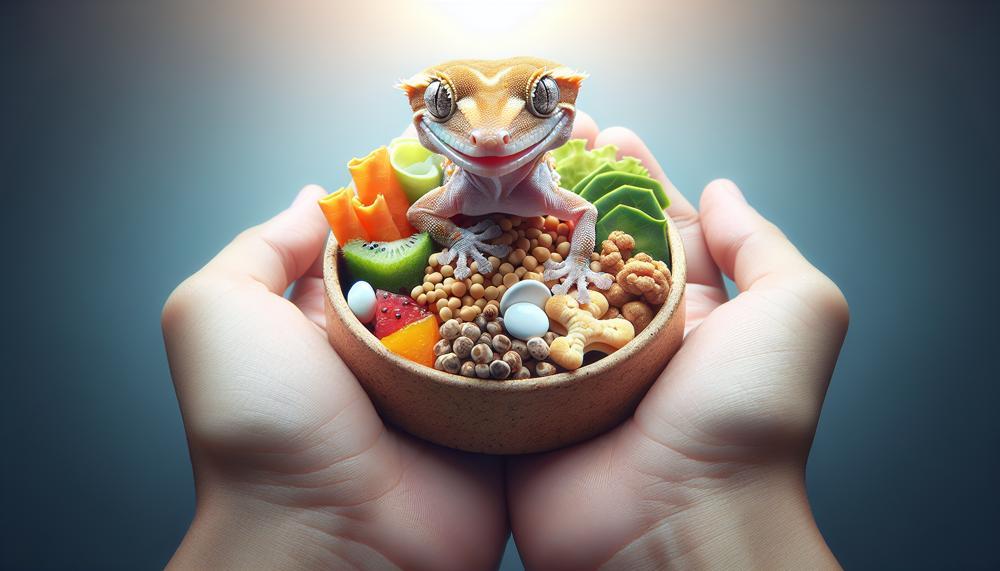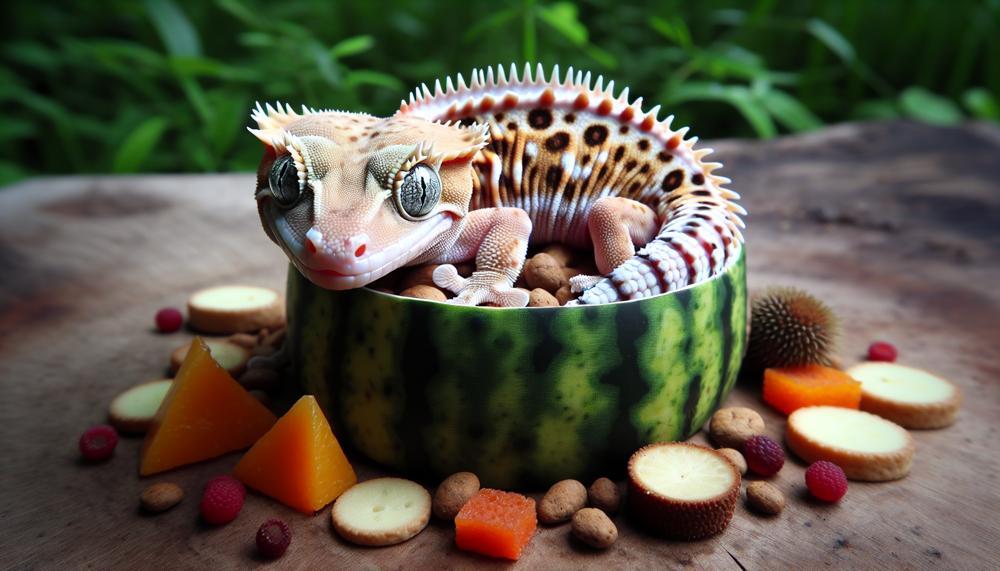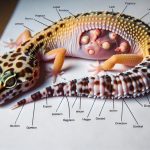These charming creatures, with their velvet-soft skin and kaleidoscopic patterns, are not only a visual delight but also captivate with their unique dietary preferences. Have you ever wondered what fuels these arboreal acrobats through their twilight antics?
You’re about to embark on a culinary journey through the treetops, revealing the surprising menu of a crested gecko’s diet.
So, what does a crested gecko eat?
Crested geckos (Correlophus Ciliatus) are omnivores that eat a variety of foods, including insects, fruits, pollen, berries, fruit juices, caterpillars, butterflies, roaches, crickets, locusts, and the remains of smaller lizards and other vertebrates. In captivity, crested geckos can live on premix powder foods, but some recommend offering a varied diet of different mashed fruits and live invertebrates with appropriate supplements. Safe fruits include blueberries, pears, papaya, strawberries, and mango.
Some insects that you can feed your crested gecko include:
- Dubia roaches: Popular, easily obtained, and packed with nutrients. You can feed them live, dead, or blended into a puree/paste.
- Crickets: You can dust crickets in calcium powder. You can also gut-load crickets before offering them to crested geckos by feeding them sustenance such as oranges and carrots.
- Silkworms: You can feed your crested gecko silkworms.
- Small hornworms: You can feed your crested gecko small hornworms.
So, let’s get started.
Contents
- 1 What Does a Crested Gecko Eat in the Wild?
- 2 The Importance of a Balanced Diet for Crested Geckos
- 3 Animal-based Foods for Crested Geckos
- 4 Plant-based Foods for Crested Geckos
- 5 Commercially Prepared Food for Crested Geckos
- 6 How to Properly Supplement Calcium in a Crested Gecko’s Diet
- 7 Tips for Feeding and Caring for Pregnant Crested Geckos
- 8 Conclusion
What Does a Crested Gecko Eat in the Wild?
Crested geckos, in their natural habitat, forage for a smorgasbord of foodstuffs that cater to their omnivorous diet. They are renowned for their versatility in dining, partaking in both animal and plant fare with equal gusto.
Their culinary journey is a testament to the bounteous provisions of the tropical rainforests of New Caledonia. Let’s delve into the specifics of their wild menu.
Insect Delicacies:
Crested geckos exhibit a marked fondness for the protein-rich banquet provided by various insects. Their diet is peppered with a medley of invertebrates, from the humble cricket to the stealthy moth.
The high protein content of these critters is crucial for their robust growth and vitality.
Fruit Buffet:
These geckos also have a sweet tooth for succulent fruits, feasting on whatever the trees bestow upon the forest floor.
Fruits like figs and mangoes not only quench their thirst but also supply a wealth of nutrients. They revel in the fallen treasures from the canopy, such as bananas and guavas, which contribute vital vitamins and minerals to their diet.
Nectar Nourishment:
Nectar, the sweet elixir of flowers, is another staple in a crested gecko’s diet. With their adept tongues, they lap up this sugary fluid, gaining carbohydrates for energy.
This penchant for nectar also casts them in the role of pollinators, an ecological service they inadvertently provide whilst feeding.
Below is a table detailing the typical fare of a crested gecko in the wild:
| Food Type | Examples | Nutritional Benefit |
| Insects | Crickets, Roaches, Moths, Flies | Protein, Vitamins, Minerals |
| Fruits | Figs, Mangoes, Bananas, Papayas, Guavas | Vitamins, Minerals, Hydration |
| Nectar | Flower nectar, Tree sap, Honeydew | Sugars, Carbohydrates |
In crafting a diet for captive crested geckos, it’s paramount to echo this natural diversity. A blend of commercial gecko fare, live insects sprinkled with calcium powder, and the occasional ripe fruit can mimic their wild diet.
The Importance of a Balanced Diet for Crested Geckos
Crested geckos thrive on a varied diet that resembles what they’d munch on in the wild.
They’re not just fussy eaters; they *need* that mix to stay in tip-top shape. Let’s chat about why a balanced diet is non-negotiable for these little critters.
Dodging the Dreaded MBD
Metabolic Bone Disease (MBD) is a real scare for geckos. It’s like osteoporosis but for our scaly pals.
To keep their bones sturdy, they need the right combo of calcium, phosphorus, and vitamin D. An off-kilter diet can lead to weak bones, and nobody wants that.
Preventing Calcium Crashes
Think of calcium as the gecko’s super fuel. Without it, their health takes a nosedive – it’s called calcium crashing, and it’s as bad as it sounds. A diet with a variety of foods ensures they get enough of this vital nutrient.
Longevity and Lifespan
Who doesn’t want their gecko buddy around for as long as possible? A balanced diet is the secret to a long and happy life. It’s not just about surviving; it’s about thriving.
Feeding Frenzy: What to Serve Up
| Food Type | Benefits | Feeding Frequency |
| Commercial Gecko Food | Formulated with essential nutrients | Daily |
| Live Insects | Protein-packed and promotes hunting behavior | 2-3 times a week |
| Ripe Fruits | Natural sugars and vitamins | Occasionally |
So, there you have it. A balanced diet is the bee’s knees for crested geckos. It keeps them robust, sprightly, and ready to leap into a long, joyful life. Remember, what goes into their belly is more than just grub; it’s the building block of their well-being.
Animal-based Foods for Crested Geckos
Crested geckos thrive when their diet mimics what they’d munch on in the wild. Their chow should be a mix of animal and plant-based grub, but let’s zero in on the critter components.
Here’s the lowdown on what these little lizards should be snacking on to keep them in tip-top shape.
Insects: The Main Event
A good chunk of a crested gecko’s diet should be creepy crawlies. These little protein-packed snacks are vital for their growth and should make up about a quarter to a third of their diet. Let’s peek at the top picks:
| Insect | Benefits | Feeding Tips |
| Crickets | Full of protein | Gut-load and sprinkle with calcium and vitamins |
| Dubia Roaches | Less chitinous than other insects | Same as crickets |
| Mealworms | Good for variety | Feed sparingly due to high fat content |
| Wax Worms | High in fat, great for treats | Don’t go overboard; they’re like candy for geckos |
Pinky Mice: A Rare Treat
For the occasional indulgence, or to beef up breeding females, pinky mice can be on the menu. They’re like the Sunday roast of the gecko world:
- When: No more than 5% of their diet
- Why: They’re a powerhouse of protein and fat
- How: Use as a treat or for pregnant females
Other Snackables
Variety’s the spice of life, so here are a few more nibbles to consider:
- Canned Snails: A gourmet option that’s rich in nutrients
- Silkworms: Soft and easy to digest
- Hornworms: Full of moisture and a good hydration source
Just remember, these are treats, not staples. Keep ’em occasional to avoid a pudgy gecko.
Plant-based Foods for Crested Geckos
Crested geckos thrive on a diet that closely mimics what they’d find in their natural habitat. Here’s a look at some choice plant-based foods and the reasons they’re vital for your little climber’s well-being:
| Food Type | Examples | Benefits |
| Fruit Purees | Mango, Papaya, Banana | Hydration, Energy, Vitamins and Minerals |
| Leafy Greens | Collard Greens, Dandelion Greens, Kale | Calcium, Fibre, Vitamin A |
| Commercial Diets | Repashy, Pangea | Convenience, Balanced Nutrition |
Commercially Prepared Food for Crested Geckos
Crested geckos thrive on a varied diet that echoes the diversity they’d encounter in the wild. Suitable commercially prepared foods are primarily powdered diets tailored to their unique nutritional requirements. Renowned brands include Repashy Crested Gecko Diet and Pangea Fruit Mix Complete Gecko Diet.
These products are a mix of plant proteins, essential vitamins, minerals, and flavors that tickle the fancy of even the pickiest geckos.
Feeding your crested gecko with the right balance of nutrients is a cinch with these products. Here’s a breakdown of the types of food and feeding schedule:
| Food Type | Description | Feeding Frequency |
|---|---|---|
| Powdered Diets | Complete nutritional solutions like Repashy and Pangea, mixed with water to create a paste or smoothie. | Juveniles: Daily Adults: Every other day |
| Live Insects | Supplemental protein source, including crickets, mealworms, and dubia roaches, gut-loaded for extra nutrition. | 2-3 times a week as a supplement to powdered diets |
| Dried Fruit and Nectar | Occasional treats to add variety and sweetness to their diet, but should not be a staple due to high sugar content. | Sparingly, as a treat |
Remember, young cresties need more frequent meals to support their growth, while adults can do with less. Keep a keen eye on their body condition and adjust the portions as needed to prevent the woe of an overweight gecko or the worry of an underfed one.
Always ensure a fresh water supply, either through a shallow dish or regular misting, to keep hydration levels shipshape.
How to Properly Supplement Calcium in a Crested Gecko’s Diet

To ensure your crested gecko thrives, it’s paramount to fortify their diet with calcium. Here are the best ways to supplement calcium and the recommended frequency.
Calcium Powder Supplements
Dust feeder insects with calcium powder to bolster your gecko’s calcium intake. Look for powders that are specifically formulated for reptiles, which can be procured from pet stores or online.
Gut-loading Feeder Insects
Prior to feeding them to your gecko, nourish feeder insects with a calcium-rich diet. This process, known as gut-loading, enhances the nutritional value of the insects.
Crested Gecko Diet (CGD)
High-quality commercial CGD is tailored to meet your gecko’s nutritional needs, including calcium. Avoid mixing CGD with other calcium supplements to prevent overdosing.
Low-Phosphorus Fruits
Offer fruits that have a low phosphorus content, such as papaya, as occasional treats. Phosphorus competes with calcium absorption, so low-phosphorus options are preferable.
Supplementation Frequency:
| Age | Calcium with D3 | Calcium without D3 |
| Babies | Daily | Thrice a week |
| Adults | Once a week | Twice a week |
| Gravid Females | With every meal | With every meal |
Monitoring Calcium Levels:
Check for calcium sacs in the mouth to judge your gecko’s calcium status. A full sac suggests adequate calcium, whereas an empty one indicates a potential deficiency.
Tips for Feeding and Caring for Pregnant Crested Geckos
Caring for a gravid (pregnant) crested gecko involves ensuring her nutritional intake is spot on to support both her wellbeing and the development of her eggs. Here’s a focused rundown:
Nutritional Breakdown for Gravid Crested Geckos
| Nutrient | Importance | Food Sources |
| Calcium | Essential for egg development and prevention of metabolic bone disease. | Calcium-dusted insects, high-calcium fruits (e.g., figs), and calcium supplements. |
| Protein | Crucial for growth and repair, especially during egg formation. | Gut-loaded live invertebrates like crickets and dubia roaches. |
| Vitamins | Overall health and proper body functions. | A varied diet of fruits, CGD, and multivitamin supplements. |
| Fiber | Supports digestive health. | Fruits and the natural plant components in CGD. |
Feeding Strategies to Meet Nutritional Needs
- High-Calcium Fruits: Serve up a mash of fruits like figs and papayas, which have a favourable calcium to phosphorus ratio, vital for reducing the risk of calcium deficiency.
- Gut-Loaded Invertebrates: Offer insects that have been fed nutritious foods (gut-loaded) 24 hours before serving. Dust these critters with a calcium supplement to boost their nutrient profile.
- Commercial Crested Gecko Diets: Choose a high-quality, filler-free CGD that mirrors the natural diet of wild crested geckos. Avoid brands with unnecessary fillers.
- Supplements: Lightly dust food with a calcium supplement two to three times a week and a multivitamin once a week. Be wary of over-supplementation, as it can cause health issues.
- Hydration: Always provide fresh water and maintain adequate humidity to assist with hydration and overall health.
Following these tips will help ensure your pregnant crested gecko gets the nutrients she needs without overdoing it.
Conclusion
In conclusion, the diverse diet of crested geckos reflects their normal intake in the environment, which is a careful balancing act between animal and plant-based meals. These fascinating reptiles thrive on a combination of sweet fruits, protein-rich insects, and nutrient-rich nectar, all of which provide crucial nutrients that are necessary for their overall health and well-being.
Replicating this food variety in captivity is crucial to preventing deficits and illnesses like Metabolic Bone Disease. Commercial gecko food, dust-dried live insects, and the odd ripe fruit may fulfill their dietary needs and replicate their natural foraging behaviors.
Recall that to maximize their nutritional worth, animal-based meals like insects should be gut-loaded and covered with supplements, while plant-based foods should be diverse and additive-free to give a variety of vitamins and fiber.
A balanced diet consisting of multiple feedings of live insects each week, daily commercial gecko food, and the odd fruit treat is essential for a crested gecko’s happiness and well-being.






